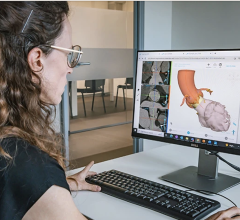
This photo shows the 3D-bioprinted cell patch in comparison to a mouse heart. When the patch was placed on a live mouse following a simulated heart attack, the researchers saw significant increase in functional capacity after just four weeks. Image courtesy of Patrick O’Leary, University of Minnesota.
April 18, 2017 — A team of biomedical engineering researchers, led by the University of Minnesota, has created a revolutionary 3-D-bioprinted patch that can help heal scarred heart tissue after a heart attack. The discovery is a major step forward in treating patients with tissue damage after a heart attack.
The research study is published in Circulation Research, a journal published by the American Heart Association. Researchers have filed a patent on the discovery.
According to the American Heart Association, heart disease is the No. 1 cause of death in the U.S., killing more than 360,000 people a year. During a heart attack, a person loses blood flow to the heart muscle and that causes cells to die. Our bodies can not replace those heart muscle cells so the body forms scar tissue in that area of the heart, which puts the person at risk for compromised heart function and future heart failure.
In this study, researchers from the University of Minnesota-Twin Cities, University of Wisconsin-Madison and University of Alabama-Birmingham used laser-based 3-D bioprinting techniques to incorporate stem cells derived from adult human heart cells on a matrix that began to grow and beat synchronously in a dish in the lab.
When the cell patch was placed on a mouse following a simulated heart attack, the researchers saw significant increase in functional capacity after just four weeks. Since the patch was made from cells and structural proteins native to the heart, it became part of the heart and absorbed into the body, requiring no further surgeries.
Watch a video of the cells beating on the patch.
“This is a significant step forward in treating the No. 1 cause of death in the U.S.,” said Brenda Ogle, an associate professor of biomedical engineering at the University of Minnesota. “We feel that we could scale this up to repair hearts of larger animals and possibly even humans within the next several years.”
Ogle said that this research is different from previous research in that the patch is modeled after a digital, three-dimensional scan of the structural proteins of native heart tissue. The digital model is made into a physical structure by 3-D printing with proteins native to the heart and further integrating cardiac cell types derived from stem cells. Three-dimensional printing is the only way to achieve the one-micron resolution needed to mimic structures of native heart tissue.
“We were quite surprised by how well it worked given the complexity of the heart,” Ogle said. “We were encouraged to see that the cells had aligned in the scaffold and showed a continuous wave of electrical signal that moved across the patch.”
Ogle said they are already beginning the next step to develop a larger patch that they would test on a pig heart, which is similar in size to a human heart.
The research was funded by the National Science Foundation, National Institutes of Health, University of Minnesota Lillehei Heart Institute, and University of Minnesota Institute for Engineering in Medicine.
In addition to Ogle, other biomedical engineering researchers who were part of the team include Molly E. Kupfer, Jangwook P. Jung, Libang Yang, Patrick Zhang, and Brian T. Freeman from the University of Minnesota; Paul J. Campagnola, Yong Da Sie, Quyen Tran, and Visar Ajeti from the University of Wisconsin-Madison; and Jianyi Zhang, Ling Gao, and Vladimir G. Fast from the University of Alabama.
Read the article "The Future of 3-D Printing in Medicine."
For more information: www.circres.ahajournals.org
Related Content About Stem Cell Therapies to Restore Heart Function
FDA Says Adult Stem Cell Research Shows Promise
Stem Cell Therapy Holds Promise for Treating Most Severe Cases of Angina
Cardiac Regeneration After MI: Role of the Extracellular Matrix
Post Heart Attack Recovery Not Aided By Stem Cell Injections, But Demonstrates Promise
Resurrecting Dead Heart Tissue


 October 21, 2024
October 21, 2024 








